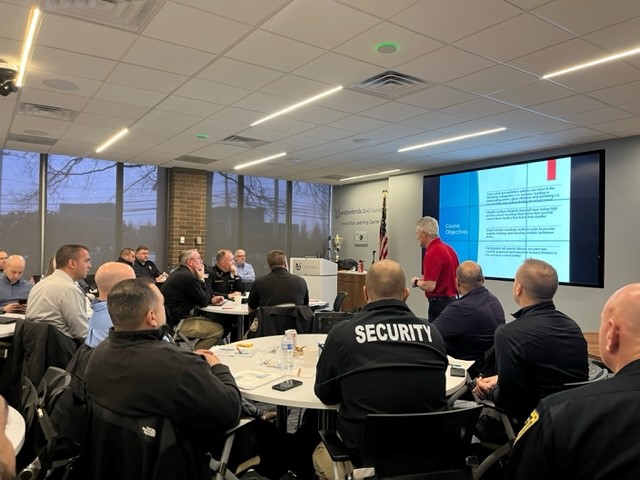Does your business know what to do in the face of an active shooter upstairs, down the hall or in the building next door?
Chances are, the answer is no. Despite the increasing number of high-profile massacres nationwide at businesses, institutions and public spaces of all sizes, it’s not standard policy for employers or facility landlords to have policies in place.
“We have mass notification systems in place for fires, but there rarely is a unified notification system to relay other types of crisis messages to people in a large private or public building or campus,” said George G. Meglio, branch director, CTi.
Mass Shootings Escalate
More than 200 mass shootings have already happened across the U.S. as of May 14, 2023, according to the Gun Violence Archive. The not-for-profit corporation formed in 2013 sources data about gun-related violence from more than 7,500 law enforcement, media, government and commercial sources daily.
In each of the last three years, there have been more than 600 mass shootings, almost two a day on average. A mass shooting is defined as an incident in which four or more people are injured or killed.
New Problems, Old Technology
“Many of the public address systems used in schools, for example, are the same technology adopted in the 1970s. It’s great for announcing routine information, but not so much in the case of an emergency,” Meglio said.
To get the message out about notifications and offer a space to discuss concerns as incidents climb, CTi and AtlasIED partnered with Jesus Villahermosa, an expert in the area of active shooters. Villahermosa was the featured speaker at a recent standing-room-only awareness seminar held by CTi and AtlasIED at the Meadowlands Chamber’s headquarters in Lyndhurst.
The seminar was geared toward education superintendents and school resource officers but the information was applicable to anyone heading any campus, facility or large building.
“You can have every preparedness plan in place for an emergency but if communication is lacking, people won’t know it’s time to execute those plans,” Meglio said.
“It’s about being prepared for everything and knowing how to mobilize,” he added.
Integrating Solutions for Emergency Reach
CTi and AtlasIED offer integrated solutions that serve as a single wire mass notification system, bringing disparate systems and devices into a single tool for emergency communications. The tools deliver audio and visual alerts to on-premises and mobile devices to expand an organization’s reach.
“The goal is to ensure no one misses a message during a critical situation,” Meglio said.
The mass communications solutions offered by CTi and AtlasIED enhance the capabilities and coverage of security and life safety systems – gunshot detection, fire alarms, video surveillance and access control.
Mandates Versus Voluntary
In today’s gun violence environment, public K-12 and higher education campuses in most states require an on-premises mass communications system that can quickly and effectively dispatch clear, concise notifications about emergencies. Federal and other grants are available.
All mass communication messages must be customized for the situation at hand, whether it’s an active shooter, a lock-down or an evacuation. When it’s a true emergency situation, the right technology offers a combination of elevated sight and sound notifications to power through any environment.
“Population density and noisy environments are attractive to shooters,” according to Villahermosa, owner of Crisis Reality Training and veteran law enforcement and lead S.W.A.T. officer. 👮
Some 90% of active shootings happen during the busiest times, he added, and while drills are important, they have to be done with reality, not comfort, in the forefront.
While it’s mandatory for most education institutions to have advanced notification systems in place, it’s not for many other types of public buildings, offices and campuses.
Therein lies a potential conundrum: If it’s not required by law, will other facility owners voluntarily adopt advanced notification systems?
Being Proactive, Being Informed
Mass shootings have escalated exponentially – the data speaks that in volumes. While these types of events aren’t new, they are happening more frequently and seemingly more random. Recall the phrase “going postal” circa 1986, when the first workplace shootings were recorded.
On Aug. 20, 1986, Oklahoma Post Office worker Patrick Henry Sherrill systematically killed 14 people, then committed suicide. Since that event, 35 people have been killed in 11 post office shootings.
- 40-plus people were killed from 1970-1997 in an estimated 20 incidents of workplace rage.
- Workplace shootings happened roughly twice per year between 1986 and 2011, with an average kill rate of 1.18 people annually.
New Jersey is one of five states with the lowest gun death rates in the nation and low rates of gun ownership, along with New York, Massachusetts, Hawaii and Rhode Island, according to statistics cited in a Violence Policy Center analysis. But low is not zero and no business or facility in any state is immune.
Putting Policies in Place
Mandates aren’t necessary when it comes to putting protocols in place and many companies, both private and public, are stepping up to put safety first. Building owners, facility directors, campus managers and more are now looking at every space under their care through a different lens, even giving special attention to outdoor areas.
At the very least, the ability to adequately deliver clear emergency alerts minimizes confusion, Meglio said. At the very most, a modern alert system for emergencies saves lives.














